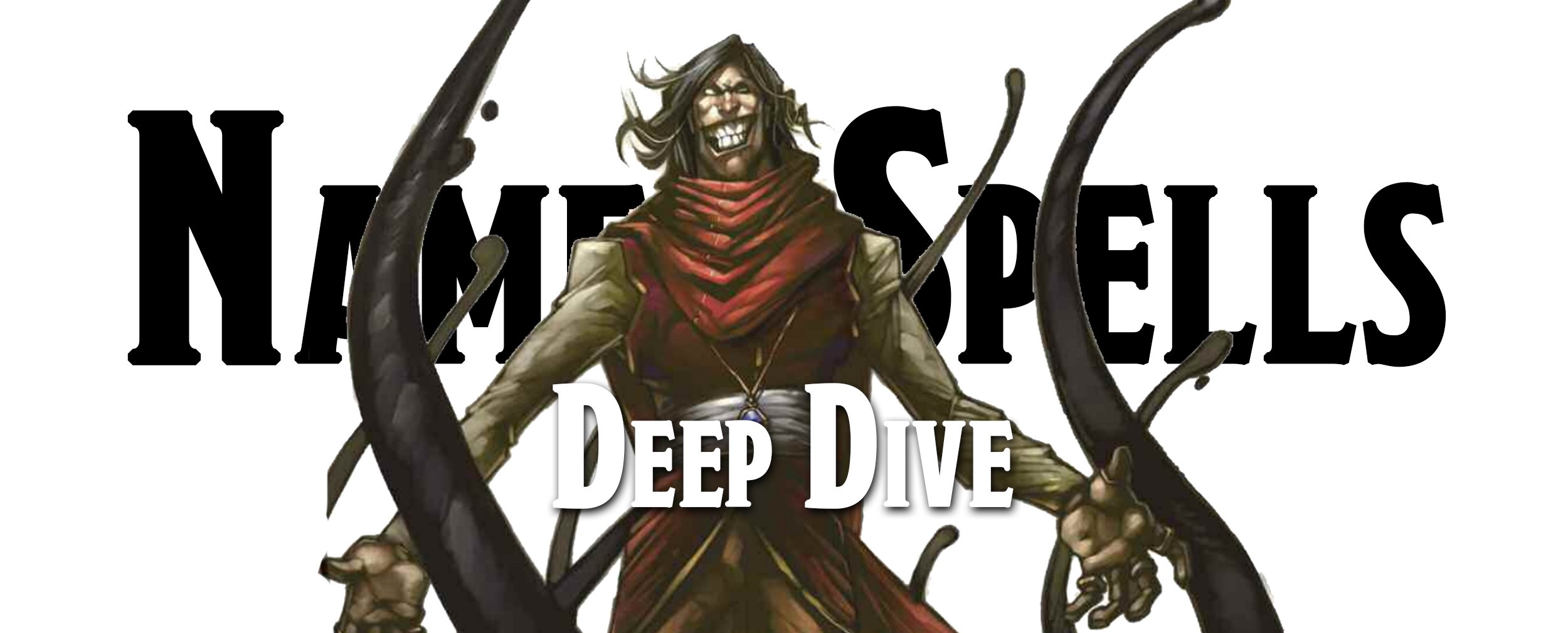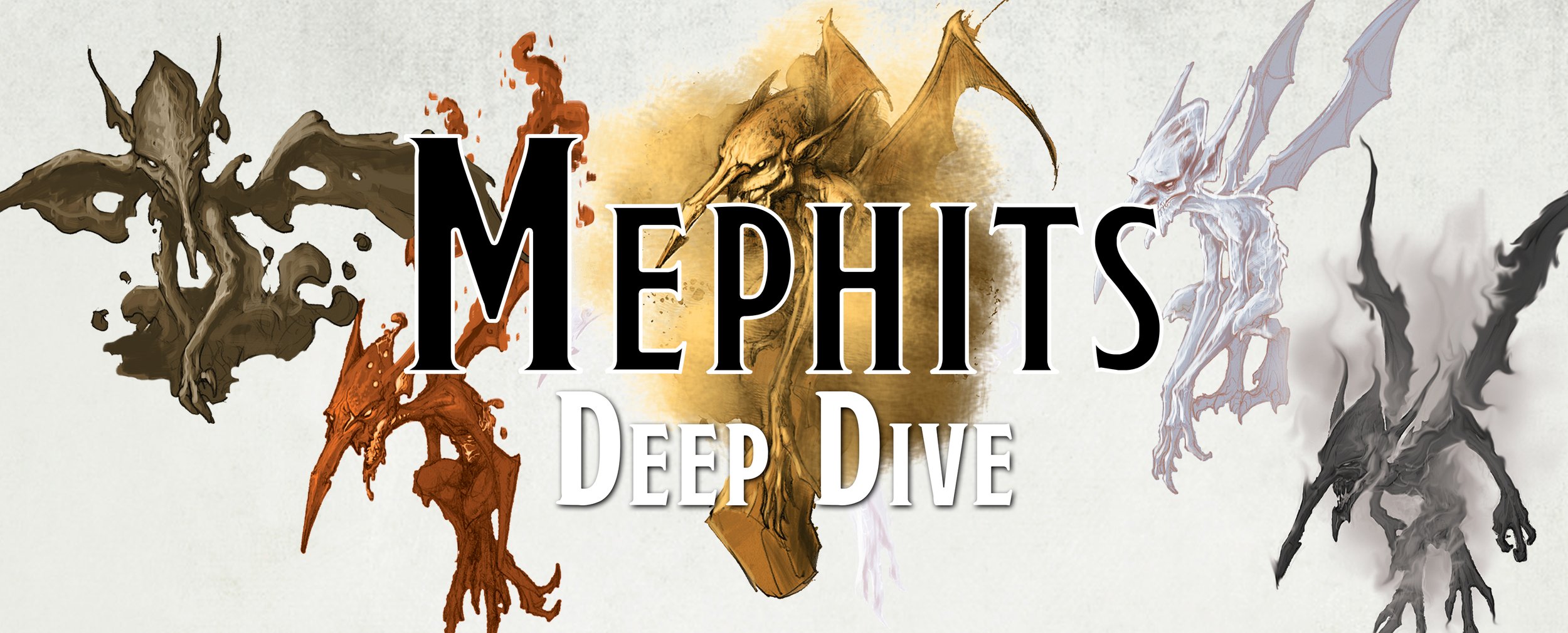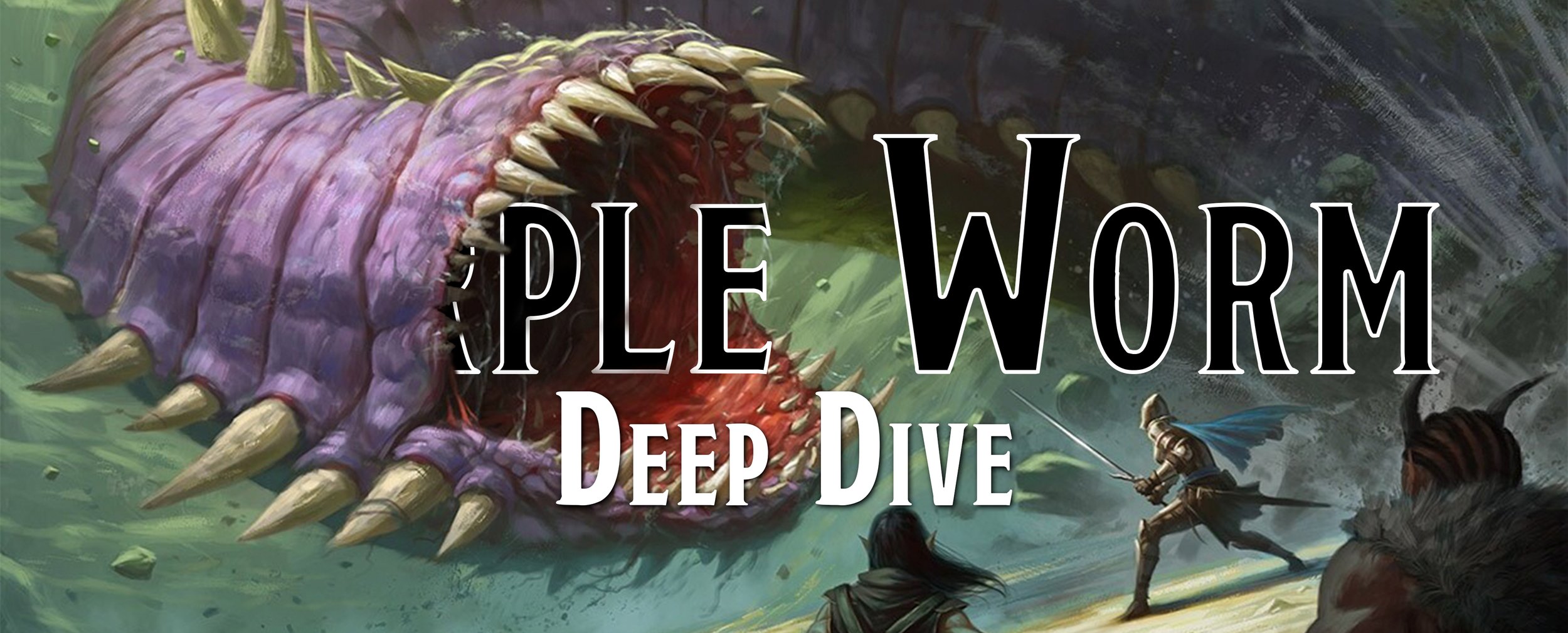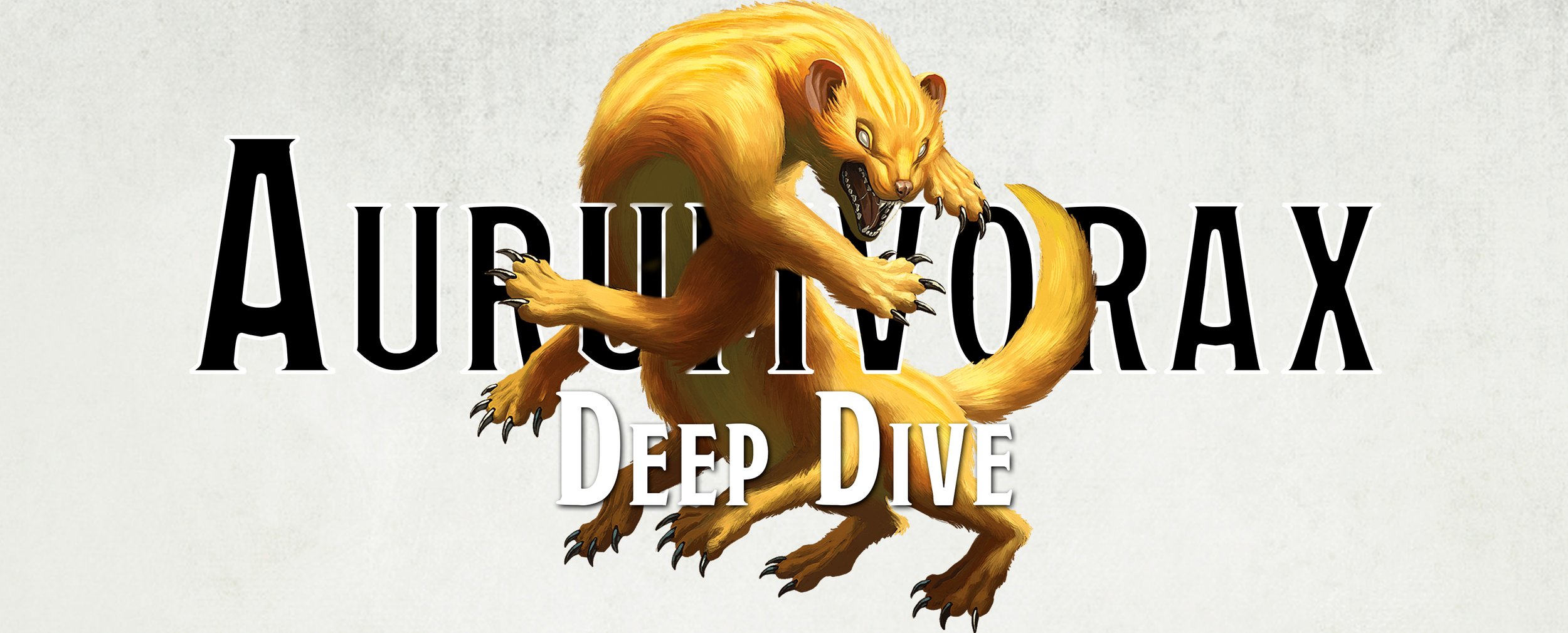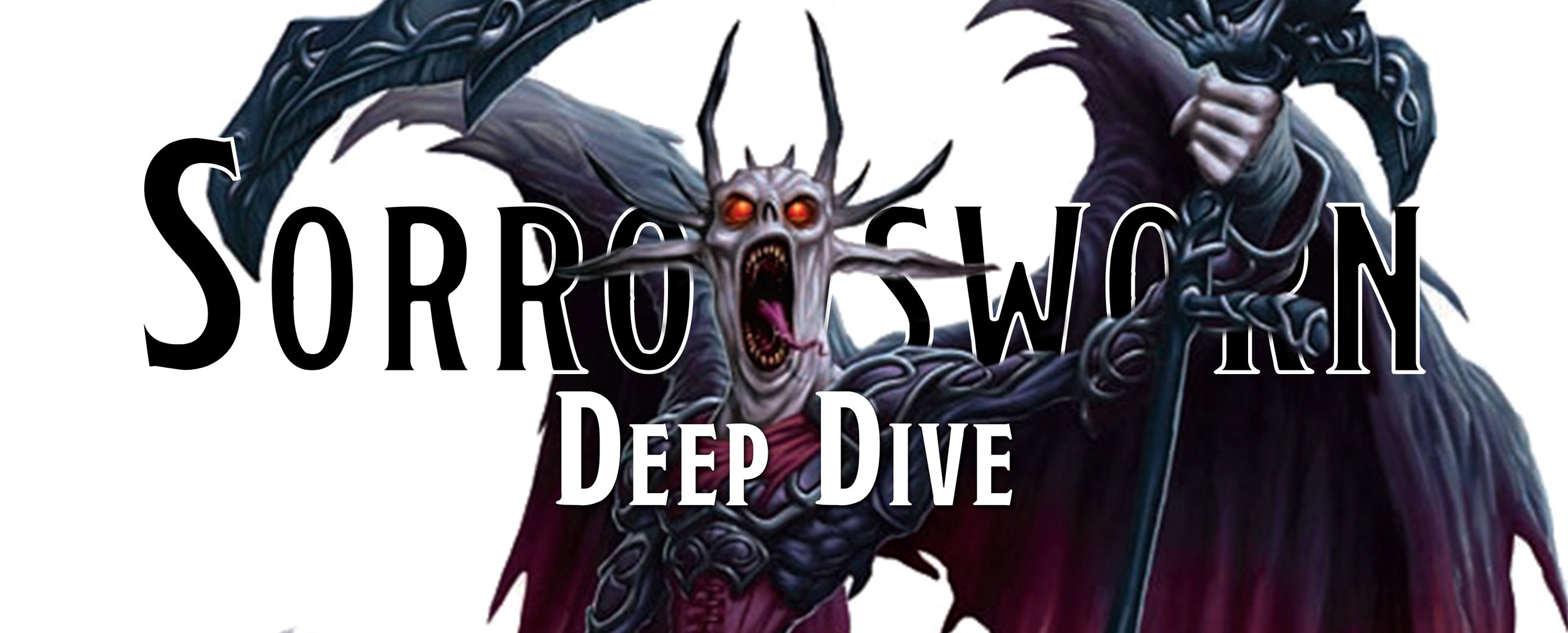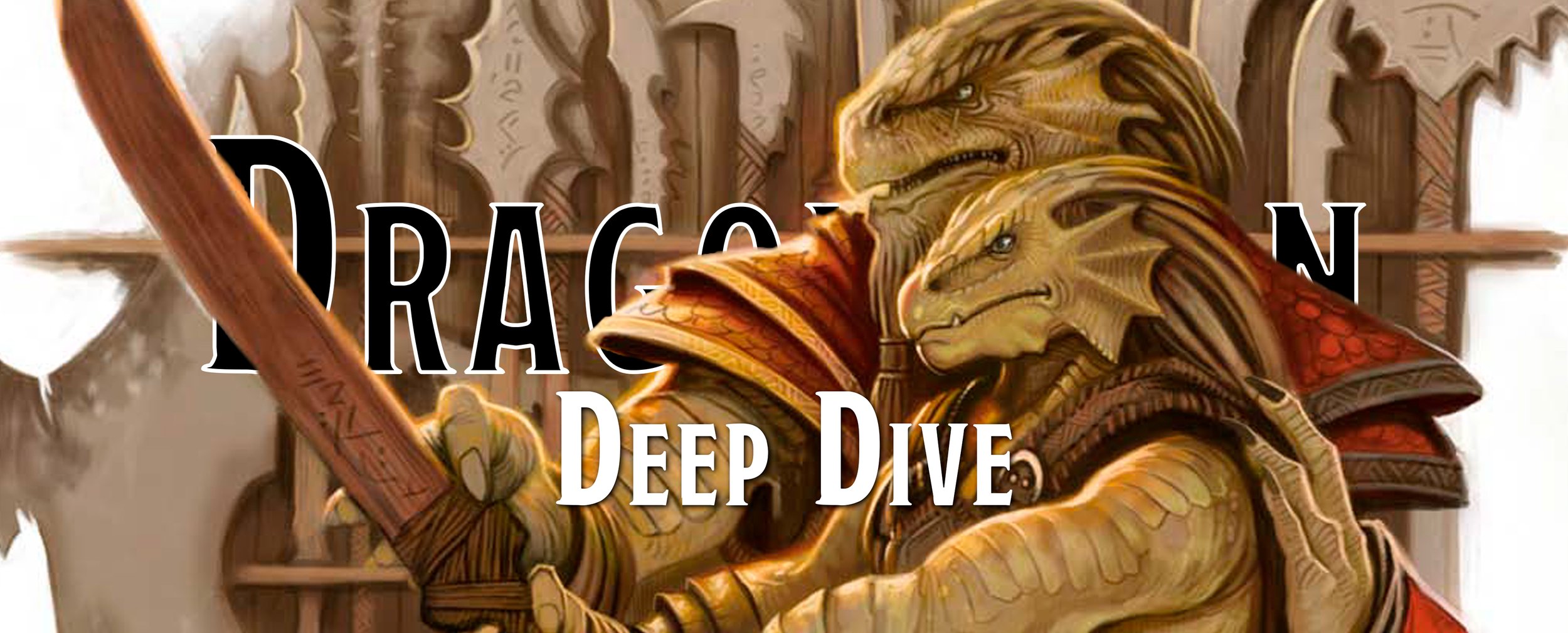Deep Dive - The Named Spells II
If you are a wizard, there’s no better way to be remembered forever than have a spell named after you. Of course, many of these wizards named the spell after themselves, but we guess that still counts.
If you are curious about the likes of Aganazzar, Drawmij, and Otto - check out part 1. If you want to learn more about Bigby and his spells, we have a deep dive focused on him!
Evard
History of the Wizard
There’s scant information about Evard, and much of what we do know comes from Dungeon #107 (February 2004). As with many of the illustrious wizards who have their names attached to spells, Evard is from the Greyhawk campaign setting. Evard was a young and ruthlessly ambitious noble from the March of Bissel and was a powerful conjurer, although, in the Living Greyhawk Gazetteer, he was described as a necromancer.
Dungeon #107, Feb. 2004 Paizo Publishing / Udon Studios
Evard’s claim to fame is being, beyond the black tendrils spells that bear his name, as being the foremost information broker in Oerth. His knowledge of legend and the arcane is unrivaled. His network of knowledge gatherers covers all of Oerth. If you needed to know something about the history of an archmage in the Principality of Ulek, your best option would be to visit Evard. It mattered not if the information was about a friend or foe, for Evard would sell both down the river for the right price.
Even then, it may not be gold that motivated Evard to spill his secrets. If you had valuable information to trade, he would often accept it in lieu of gold. It was also common for Evard to pass along what he knew just to increase his reputation and infamy. He’d sell out his own mother if he thought it would help him in the long run. So remember, if you have secrets to hide, Evard might very well spill beans to your most dreaded nemesis.
Evard is the author of the spell book Legendary Ghosts and Phantoms and has two additional spells to his name; Evard’s menacing tentacles and Evard’s all-seeing worm.
History of Evard’s Black Tentacles
2nd Edition - Player's Handbook (1989)
(Conjuration/Summoning)
Range: 30 yards
Components: V, S, M
Duration: 1 hour/ level
Casting Time: 1 round
Area of Effect: 30 sq. ft / level
Saving Throw: None
This spell creates many rubbery, black tentacles in the area of effcct. These waving members seem to spring forth from the earth, floor. or whatever surface is underfoot-including water. Each tentacle is 10 feet long, AC 4. and requires as many points of damage to destroy as the level of the wizard who cast the spell. There are 1d4 such tentacles. plus one per experience level of the spellcaster.
Any creature within range of the writhing tentacles is subject to attack as determined by the DM. The target of a tentacle attack must roll a saving throw vs. spell. If this succeeds, the subject suffers 1d4 points of damage from contact with the tentacle. and then the tentacle is destroyed. Failure to save indicates that the damage inflicted is 2d4 points, the ebon member is wrapped around its subject, and damage will be 3d4 points on the second and third rounds. Since these tentacles have no intelligence to guide them, there is the possibility that they entwine any object - a tree, post. pillar. even the wizard himself - or continue to squeeze a dead opponent. A grasping hold established by a tentacle mnains until the tentacle is destroyed by some form of attack or until it disappears at the end of the spell’s duration.
The component for this spell is a piece of tentacle from a giant octopus or giant squid.
So let’s get the elephant in the room out of the way. This sounds like some sort of horrible hentai-inspired spell. Rubbery tentacles and waving members that spring forth all sound like something you’d find in the dark recesses of the internet. The description is unfortunate, but if you can get your mind out of the gutter, you’ll see that this is a great crowd-control spell. It does come with some issues, but at least they don’t include the tentacles attacking you.
The minimum number of hit points each tentacle can have is 7 - it’s a 4th-level spell, requiring our wizard to be at least 7th level. The biggest issue with this spell is that the DM determines who is grasped by the tentacles. It’s a wide area of effect, and the chance of a melee party member getting grabbed is high if a tentacle appears next to an enemy they are fighting. With a range of 10 feet, positioning yourself away from the writhing black ickiness while maintaining melee range could prove quite difficult indeed.
The spell damage is low for a fourth-level spell, especially since we all know any wizard would rather cast a fireball. While the damage isn’t great, it does increase over time, and its victim is grappled. That gives the spell a little more oomph unless, of course, you’re the one grappled.
3rd Edition - Player's Handbook (2003)
Conjuration (Creation)
Level: Sor/Wiz 4
Components: V, S, M (a piece of tentacle from a giant octopus or a giant squid)
Casting Time: 1 standard action
Range: Medium (100 ft. + 10 ft./level)
Area: 20-ft.-radius spread
Duration: 1 round/level (D)
Saving Throw: None
Spell Resistance: No
This spell conjures a field of rubbery black tentacles, each 10 feet long. These waving members seem to spring forth from the earth, floor, or whatever surface is underfoot—including water. They grasp and entwine around creatures that enter the area, holding them fast and crushing them with great strength.
Every creature within the area of the spell must make a grapple check, opposed by the grapple check of the tentacles. Treat the tentacles attacking a particular target as a Large creature with a base attack bonus equal to your caster level and a Strength score of 19. Thus, its grapple check modifier is equal to your caster level +8. The tentacles are immune to all types of damage.
Once the tentacles grapple an opponent, they may make a grapple check each round on your turn to deal 1d6+4 points of bludgeoning damage. The tentacles continue to crush the opponent until the spell ends or the opponent escapes.
Any creature that enters the area of the spell is immediately attacked by the tentacles. Even creatures who aren’t grappling with the tentacles may move through the area at only half normal speed.
Some substantial changes/rules definitions in the 3rd edition. It’s now a wizard, sorcerer, and cleric spell. You can only take the spell if you’re a Slime domain cleric, and honestly, it’s a bizarre domain choice. These tentacles lash out at all creatures in their area, attempting to grapple and squeeze them to death - so not something you can use when your barbarian throws themselves into the melee with little regard for ‘placement’.
On the topic of grappling, size is a big decider of who wins such competitions. Typically larger creatures have an easier time of grabbing on to smaller creatures, so it is nice that the tentacles count as Large sized creatures when they are probably not that big. Then again, maybe the black tentacles spell is actually summoning the bottom portion of a kraken to attack your enemies.
5th Edition - Player's Handbook (2014)
4th-level conjuration
Casting Time: 1 action
Range: 90 feet
Components: V, S, M (a piece of tentacle from a giant octopus or a giant squid)
Duration: Concentration, up to 1 minute
Squirming, ebony tentacles fill a 20-foot square on ground that you can see within range. For the duration, these tentacles turn the ground in the area into difficult terrain.
When a creature enters the affected area for the first time on a turn or starts its turn there, the creature must succeed on a Dexterity saving throw or take 3d6 bludgeoning damage and be restrained by the tentacles until the spell ends. A creature that starts its turn in the area and is already restrained by the tentacles takes 3d6 bludgeoning damage.
A creature restrained by the tentacles can use its action lo make a Strength ar Dexterity check (its choice) against your spell save DC. On a success, it frees itself.
Not much new to cover here. It’s back to being a 4th-level spell, and concentration is still required. The area of effect is shrunk to a mere 20 feet, and everyone in the area is affected. A Dexterity check may not be the worst for your rogue, but the fighter or paladin may have some issues. You’re not Grappled but Restrained. That condition more than offsets the slight decrease in damage.
Additional Evard Spells
There are only two, both of which exist in the 2nd edition, Evard’s menacing tentacles and Evard’s all-seeing worm. We aren’t sure what Evard’s relationship with tentacles and worms and writhing is, but it sure does seem to come up a lot with him.
Evard’s menacing tentacles is a spell that causes two tentacles to sprout from your shoulders, they then lash out at your enemies, striking them and maybe even tearing them apart. It’s kind of like Doctor Octopus from Spiderman but less robot and more fleshy tentacle.
The other spell, Evard’s all-seeing worm is a lot more disgusting and was first shown off in Dungeon #107. You create a worm in your hand, and then hand it to an ally of yours for them to ingest. As soon as the creature puts it in their mouth, the worm burrows into their brain and makes them sick for a little bit. So far you probably are wondering what the upsides are to this spell… or if you are really weird, what are the downsides. Well the worm-brain creature gains a bonus to knowledge checks, and the caster of the spell can now see through your eyes and hear through your ears. The caster also knows exactly where their worm is located and how far away they are, so it has some uses. The downsides are that you have to eat a worm and that when the spell ends, you have to puke up the worm again.
Melf
History of the Wizard
The archmage Melf, also known as Prince Brightflame, was the player character of Paul Gygax in Gary Gygax’s home game. He also appears in the novel Artifact of Evil (1986) by Gary Gygax. Melf is a grey elf, and his name is M for male and elf (his race) combined to spell Melf. Straightforward and simple. Known to be opinionated and vain, Melf is 5'8", 147 lbs, and about 200 years old, even though he appears twenty years old in human terms. He lives in the elven kingdom of Celene and was also recognized as the head of the Knights of Luna.
Melf is an ally of Mordenkainen and was once a member of the Circle of Eight and a former member of the Citadel of Eight. His loyalty remains with Mordenkainen, assisting the Circle of Eight in its fight against Iuz and the Scarlet Brotherhood. His focus in life is on fighting evil, which probably explains his willingness to battle Iuz, one of the evilest creatures in Greyhawk. When he is engaged in battle, Melf wielded a magical spear and shield and also owned a cloak of illusions, elven chainmail, a spellbook, and an exploding meteor. Now sure exactly what an exploded meteor is, but it sounds wonderful and deadly.
Melf is known for creating three spells, and the one we are interested in is probably his most famous, Melf’s acid arrow. An arcane spell from the conjuration school of magic, when cast, fires an arrow of acid from the caster's hand, which corroded the target well after the initial arrow strike.
History of Melf’s Acid Arrow
1st Edition - Unearthed Arcana (1985)
Level: 2
Components: V, S, M
Range: 3”
Casting Time: 4 segments
Duration: Special
Saving Throw: Special
Area of Effect: One target
By means of this spell, the magic-user creates a magic “arrow” which speeds itself to its target as if fired from the bow of a fighter of the same level as the magic-user casting the spell. The arrow is equal to a +1 weapon for hit determination purposes. The effect of a hit might inflict damage on the target even if it would not normally be harmed by an arrow or magic weapon of only +1 value. This is due to the acid. The arrow itself does 2-5 points of damage. The acid which gushes forth when it hits is equal to an acid missile of 8-ounce volume (1v diam. area of effect, 2-8 hit points damage, plus item saving throw; splash does not apply). The acid’s strength increases by one round’s worth of damage for every 3 levels of experience of the spell caster above the 3rd, so that damage will occur over two rounds if the spell cast is from a 4th-6th level magic-user, unless the target can have the acid neutralized. The material components of the spell are a dart and powdered rhubarb leaf and adder stomach.
The wizard points its finger at a target, and an arrow shoot from it as if it had been shot from a bow. You know, except a finger. It counts as a magical weapon which is nice, for even a +1 bonus helps. Every little bit helps since everything is literally trying to kill you. The arrow only does 2-5 points of damage, but then the real fun begins.
The released acid, for lack of a better description, hurts. Acid damage isn’t fun, and you’ll take an additional 2-8 points on damage, and the acid burns through your skin. It gets worse too. For every 3 levels the caster has above 3rd level, the acid damage lasts an extra round. The poor soul that is watching the skin melt off their body can stop the damage by neutralizing the acid, but how that happens is anyone’s guess. Hopefully, someone is carrying a jug of vinegar with them - or maybe this is one of those jelly-sting things where you have to pee on them.
2nd Edition - Player’s Handbook (1985)
Range: 180 yards
Components: V, S, M
Duration: Special
Casting Time: 2
Area of Effect: 1 target
Saving Throw: Special
By means of this spell, the wizard creates a magical arrow that speeds to its target as if fired from the bow of a fighter of the same level as the wizard. No modifiers for range, nonproficiency, or specialization are used. The arrow has no attack or damage bonus, but it inflicts 2d4 points of acid damage (with saving throws for items on the target); there is no splash damage. For every three levels that the caster has achieved, the acid unless somehow neutralized, lasts for another round, inflicting another 2d4 points of damage each round. So at 3rd–5th level, the acid lasts two rounds; at 6th–8th level, the acid lasts for three rounds, etc. The material components of the spell are a dart, powdered rhubarb leaf, and an adder’s stomach.
Melf’s arrow is similar to before with no extra special properties beyond dealing the 2d4 acid damage it inflicts. Though, you do get to treat your attack roll as if you had the full attack bonus that a fighter has, instead of using the wizard’s. This simply means that your chances of hitting a creature are just a few points better. Additionally, the attack only affects the target. We guess that unlike throwing a vial of corrosive acid and gaining a splash effect, all of the acid is centered on one poor soul.
The multi-round damage increase remains, so the higher level the casting wizard is, the longer the target has to watch as the acid burns through the skin, down to their bones. We are starting to think that maybe this spell should come with a disclaimer about improperly handling hazardous materials.
3rd Edition - Player’s Handbook (2003)
Conjuration (Creation) [Acid]
Level: Sor/Wiz 2
Components: V, S, M, F
Casting Time: 1 standard action
Range: Long (400 ft. + 40 ft./level)
Effect: One arrow of acid
Duration: 1 round + 1 round/three levels
Saving Throw: None
Spell Resistance: No
By means of this spell, the wizard creates a magical arrow that speeds to its target as if fired from the bow of a fighter of the same level as the wizard. No modifiers for range, nonproficiency, or specialization are used. The arrow has no attack or damage bonus, but it inflicts 2d4 points of acid damage (with saving throws for items on the target); there is no splash damage. For every three levels that the caster has achieved, the acid, unless somehow neutralized, lasts for another round, inflicting another 2d4 points of damage each round.
So at 3rd–5th level, the acid lasts two rounds; at 6th–8th level, th acid lasts for three rounds, etc. The material components of the spell are a dart, powdered rhubarb leaf, and an adder’s stomach.
There is basically no change in this spell from the previous edition, which is probably for the best. Based on how much detail this edition likes to get into on how victims are slowly melted in acid, charring bones, swallowing worms, and more, it’s probably best for our stomachs we didn’t get more detail.
4th Edition - Player’s Handbook (2008)
A shimmering arrow of green, glowing liquid streaks to your target and bursts in a spray of sizzling acid.
Daily Acid, Arcane, Implement
Standard Action Ranged 20
Primary Target: One creature
Attack: Intelligence vs. Reflex
Hit: 2d8 + Intelligence modifier acid damage, and ongoing 5 acid damage (save ends). Make a secondary attack.
Secondary Target: Each creature adjacent to the primary target
Secondary Attack: Intelligence vs. Reflex
Hit: 1d8 + Intelligence modifier acid damage, and ongoing 5 acid damage (save ends).
Miss: Half damage, and ongoing 2 acid damage to primary target (save ends), and no secondary attack.
Not named Melf’s acid arrow, but just acid arrow, the spell is adapted in the way that all things for Dungeons & Dragons needed to be, providing a pretty clear format to read the effects of the spell. Most importantly, the arrow now deals splash damage to adjacent creatures to the target, so you get to watch more than one creature slowly melt from acid. Lucky you.
5th Edition - Player’s Handbook (2014)
2nd-level evocation
Casting Time: 1 action
Range: 90 feet
Components: V, S, M (powdered rhubarb leaf and an adder’s stomach)
Duration: Instantaneous
A shimmering green arrow streaks toward a target within range and bursts in a spray of acid. Make a ranged spell attack against the target. On a hit, the target takes 4d4 acid damage immediately and 2d4 acid damage at the end of its next turn. On a miss, the arrow splashes the target with acid for half as much of the initial damage and no damage at the end of its next turn.
At Higher Levels. When you cast this spell using a spell slot of 3rd level or higher, the damage (both initial and later) increases by 1d4 for each slot level above 2nd.
It’s still a cool green arrow and the damage now has you rolling four fun little d4 triangle dice, and the damage lasts for two rounds. The splash effect doesn’t hit anyone else, but even on a miss, you’ll do half damage to the target. It’s always nice to do damage, even when you miss. The spell scales, and even though it’s not the greatest, casting it using a higher level allows you to roll many more d4s. And who doesn’t love trying to pick up those annoying triangles and then trying to actually roll those horrible things?
Additional Melf Spells
Melf has two other spells of note to his name. The first is the well-known Melf’s minute meteors. It’s a nasty little spell found in the 2nd, 3rd, and 5th editions. The spell create six tiny meteors that orbited the caster for up to 10 minutes. Now you’ll have to concentrate for those ten minutes, but we’re fairly sure you’ll have sent out all six of the exploding rocks well before then. When you fire a meteor off at a target. When released, the meteors exploded on impact, and everyone within 5 feet of the point where the meteor explodes must make a Dexterity saving throw or take 2d6 fire damage on a failed save or half as much damage on a successful one. It’s better to hurtle a meteor and the ground with multiple targets, but if someone or something really pissed you off, just fire off a couple of the exploding rocks at them.
The second spell is lesser known, and only appears in the 3rd edition. Melf’s unicorn arrow has the caster firing off a shimmering, transparent form of a unicorn. Its head pointed downwards so as to appear as if the creature’s horn was headed straight towards you. If you succeed on a ranged touch attack, the horn slams into the target and deals 1d8+8 points of damage. It keeps improving, though, as the target needs to make a Strength check or be pushed back 5 feet, plus an additional 5 feet for every 5 points by which it failed the check.
You can you upcast the spells, and you get to shoot off more tiny unicorns at people. For every 3 levels past the 5th, you can cast another unicorn arrow, maxing out five arrows at the 17th level. The caster can target a poor single creature or multiple targets in the same vein as a magic missile spell. Death by unicorn arrows doesn’t seem like a bad way to die…except for the whole dying part.
Snilloc
History of the Wizard
Snilloc was another of the great wizard of his time, known for creating three cold-based spells, Snilloc’s snowball, Snilloc’s snowball swarm, and Snilloc’s major missile. Like many of the great wizards we have profiled here, Snilloc was arrogant and opinionated. These attributes were apparent in his writing, so not only did he sound like a pompous jerk when he spoke, but also when he wrote.
The snowball swarm was developed by the wizard Snilloc who lived sometime in the 13th century DR. It was inscribed in The Collected Wisdom of Snilloc, which was a 120-page compilation of his writings, spell creations, and musing about the world around him. The spells contained in the books were his original spells, snowball and major missile, but they also contained a few spells not attributed directly to him. The book was kept in his personal library but was stolen a few years later. Thankfully, a number of copies are floating around the Faerun, as the location of the original is still unknown.
Snilloc, beyond his spell inventions, was most famous for saving the city of Procampur from a massive horde of hobgoblins intent on sacking the city. Snilloc was one of the many mages that were ticked off when he found out his spells were published in Volo's Guide to All Things Magical in 1369 DR. He was so infuriated with the whole mess that he said that Volo should be decapitated and spend eternity as a dung beetle crushed under a rock that was at the bottom of a cesspool. Needless to say, Snilloc was very pissed off.
The last thing is that if you have ever worried that your character’s name isn’t every good, don’t worry Snilloc and Melf will keep them company. Snilloc was the creation of Dave Collins, a player in Jeff Grubbs games. We only mention that because Snilloc is just Collins backward. Really goes to show names have always been the hardest part of playing role-playing games for everyone.
History of Snilloc’s Snowball Swarm
2nd Edition - Wizard’s Spell Compendium 3 (1988)
(Evocation)
Range: 10 yards/level
Components: V,S,M
Duration: Instantaneous
Casting Time: 2
Area of Effect: 30-foot radius
Saving Throw: 1/2
By means of this spell the caster causes a flurry of magical snowballs to erupt from a point within his range. The snowballs fly in all directions, hitting everything in the area of effect (including the caster) and causing 1-3 points of damage per level of the caster (to a maximum of 8d3). Against fire-using and fire-dwelling creatures, the spell inflicts 1-6 points of damage per level of the caster (again to a maximum of 8 dice of damage).
Unlike the higher-level fireball, the snowball swarm is completely contained within its area of effect. Obstructions and low ceilings do not cause the cloud of snowballs to deform —they just hit the walls and splatter. These snowballs are considered normal missiles when determining the effects of protection spells. However, all targets are considered AC 10 against the snowballs; only Dexterity modifiers apply.
This spell is much less powerful than the fireball spell but useful where the dimensions of the area of effect are unknown or against fire-using or fire-dwelling creatures. The material component of this spell is a chunk of ice or a single pearl.
This 2nd-level spell takes the 1st-level Snilloc’s snowball and amps this spell to a whole new level. Whereas the Snilloc’s snowball fires off a single snowball, the snowball swarm causes a flurry of snowballs, pummeling everyone with range. They only do 1-3 damage, which is a shame but unsurprising. If you’ve never been in a snowball fight, they don’t hurt very much, except when you get hit in the face and some kobold hid a rock in it.
What makes the spell interesting is that no matter what armor you wear, your Armor Class is only 10 plus any Dexterity modifier. We’re not sure why plate mail wouldn’t protect you against snowballs, but we’ll take the spell getting a bit more oomph. If you travel to the Plane of Fire or know you’ll fight creatures who love fire, a snowball does 1d6 damage. It makes the spell a situational spell, but having a spell in your book that can do up to 8d6 damage against a bunch of salamanders is worth having.
3rd Edition - Forgotten Realms Campaign Setting (2001)
Evocation (Cold)
Level: Sor/Wiz 2
Components: V, S, M (a piece of ice or a small white rock chip)
Casting Time: 1 action
Range: Medium (100 ft. + 10 ft./level)
Effect: 10-ft.-radius burst
Duration: Instantaneous
Saving Throw: Reflex half
Spell Resistance: Yes
A flurry of magic snowballs erupts from a point you select. The swarm of snowballs deals 2d6 points of cold damage to creatures and objects within the burst. For every two caster levels beyond 3rd, the snowballs deal an extra die of damage, to a maximum of 5d6 at 9th level or higher.
The spell is nerfed regarding its area of effect, but its damage is increased to a respectable 2d6 cold damage. The bonus damage against fire creatures goes away, which reduces the damage of the spell as you level up, so we aren’t sure if it is really worth keeping on hand at all times.
The spell also appears in the 3.5e Spell Compendium (2005). Nothing changes, but there is a neat little passage at the beginning of the description. When you cast the spell, you feel cold, as if the spell is building up through the chill in your body. Once the spell is cast the cold erupts from your body as the snowballs begin to rain down upon your foes. It’s a fun flavor context that doesn’t involve tentacles, worms, or face-melting, so we’ll take it.
5th Edition -Elemental Evil Player’s Companion (2015)
2nd-level evocation
Casting Time: 1 action
Range: 90 feet
Components: V, S, M (a piece of ice or a small white rock chip)
Duration: Instantaneous
A flurry of magic snowballs erupts from a point you choose within range. Each creature in a 5-foot-radius sphere centered on that point must make a Dexterity saving throw. A creature takes 3d6 cold damage on a failed save, or half as much damage on a successful one.
At Higher Levels. When you cast this spell using a spell slot of 3rd level or higher, the damage increases by 1d6 for each slot level above 2nd.
We’ve got good news and bad news for 5th edition. The area of effect is decreased to only a 5-foot sphere. All things considered, that’s a very small area for our snowballs to pummel your opponents. For the poor soul in that area that fails their save, they will take upwards of 18 cold damage, which is more than the previous editions. In fact, the damage can increase all the way to 10d6 if you use a 9th-level spell slot. I know you’re probably not going to do that, but it’s not so much you would as much as you could. Of course, that isn’t actually great scaling for such a small area of effect, especially since a fireball spell deals 8d6 in a 20-foot radius at 3rd-level.
Now that we say that out loud, or typed it out loud, this spell kind of sucks.
Additional Snilloc’s Spells
Snilloc has a few other spells to his name: Snilloc’s snowball, Snilloc’s major missile, and Snilloc’s cream pie. The snowball spell is a 1st-level spell that essentially allows the caster to throw a snowball at someone. Found in the 2nd and 3rd editions, the snowball was a frozen version of a magic missile. You could miss with it, but it did very little damage and was susceptible to the same spells that negated a magic missile. Though, it did more damage to fire-based creatures. You could also upcast it, and while your snowball could strike someone really far away, there was still only one snowball.
Snilloc’s major missile is found in the 2nd edition sourcebook Forgotten Realms Adventures (1990), with a detailed description of the spell found in the book Pages from the Mages (1995). Snilloc worked tirelessly in creating this spell after the Avatar crisis. Apparently, a lot of magic missiles were used during the crisis, and they discovered that it wasn’t very effective at higher levels. Probably not the best time to figure that out. Functioning as a powered-up magic missile, Snilloc’s major missile had increased damage but was limited to a single creature target. The missile delivered 1d4+1 points of damage, but the spell did an additional 1d4+1 for every two levels after, capping out a maximum of 15d4+15.
Finally, there is Snilloc’s cream pie. The only mention of the spell is found in the Wizard’s Spell Compendium, Volume 3 (1998). There’s no actual spell listed, only that it’s a rumored spell that functions like his snowball spell, but instead of a snowball, you launched a cream pie at someone. Fun times.
So there you have it; three more spells created by wizards who thought so much of themselves they slapped their names on the spells they created. There may not be a Tasha or a Bibgy, but you’d never remember the name Melf if it wasn’t for his acid arrow… or the fact it’s just male and elf shoved together.
If you enjoy our Deep Dive series, consider
supporting us on Patreon and following us on Twitter!

